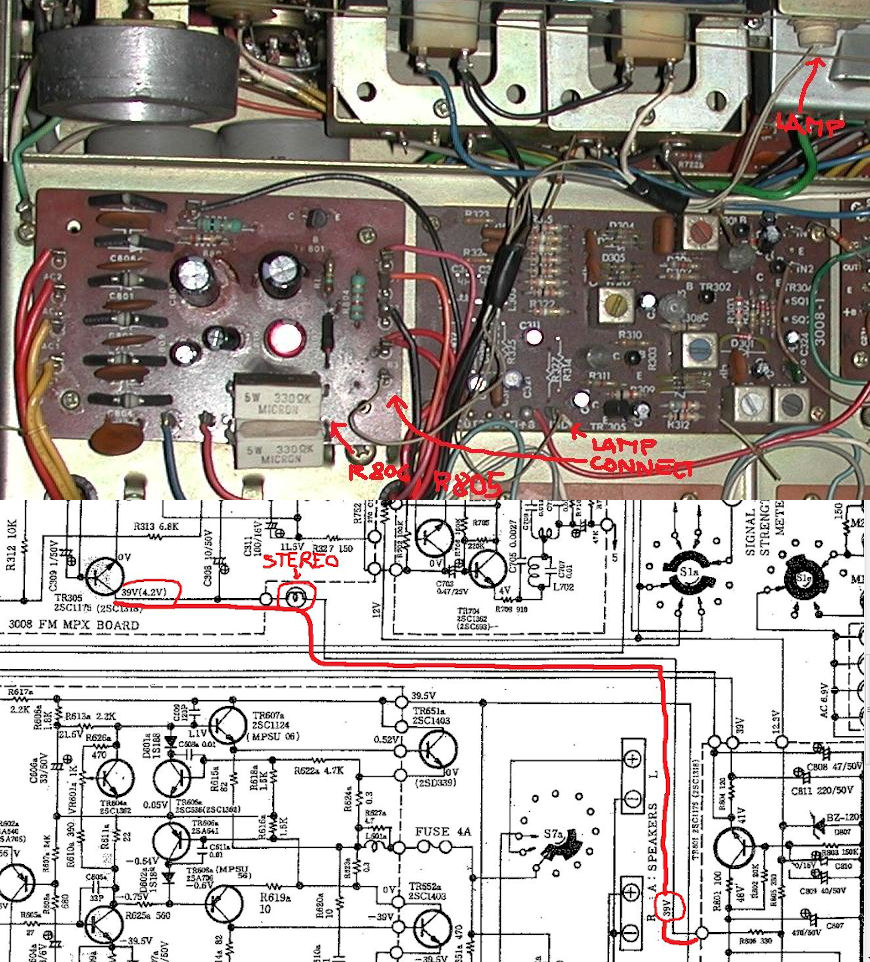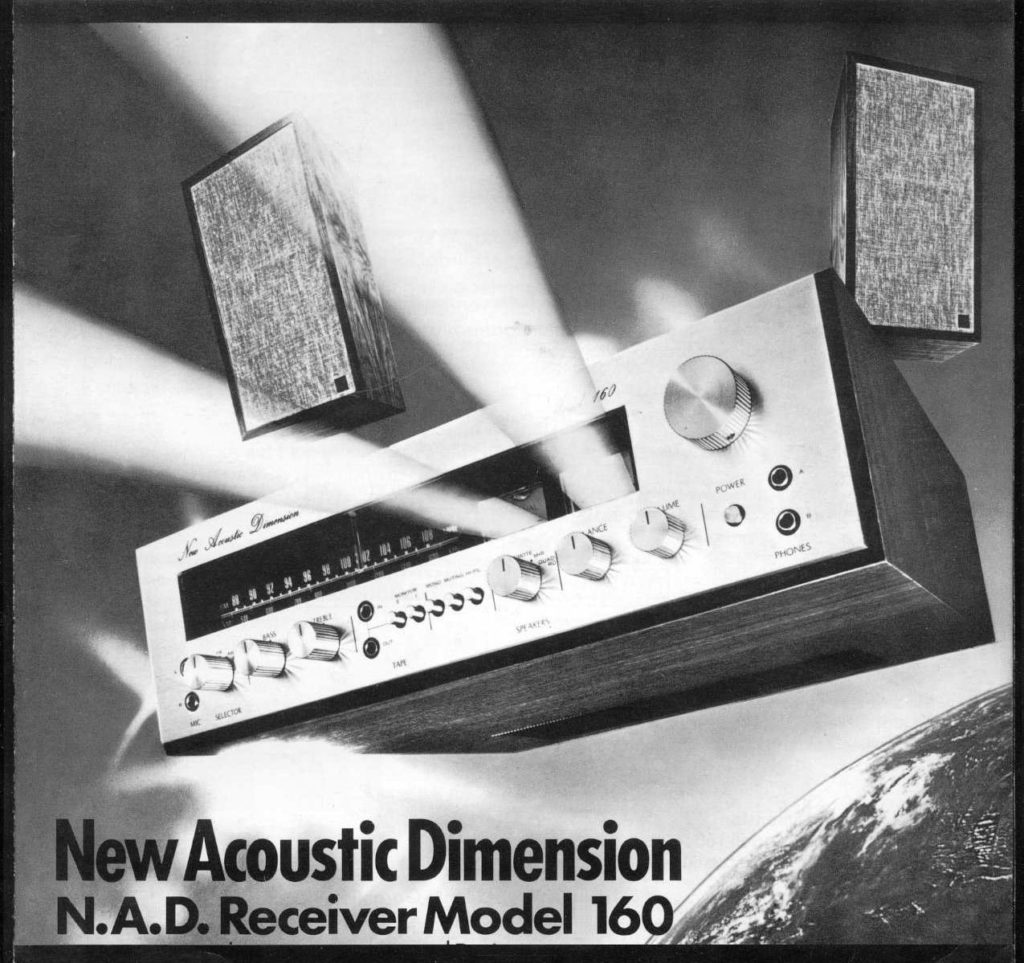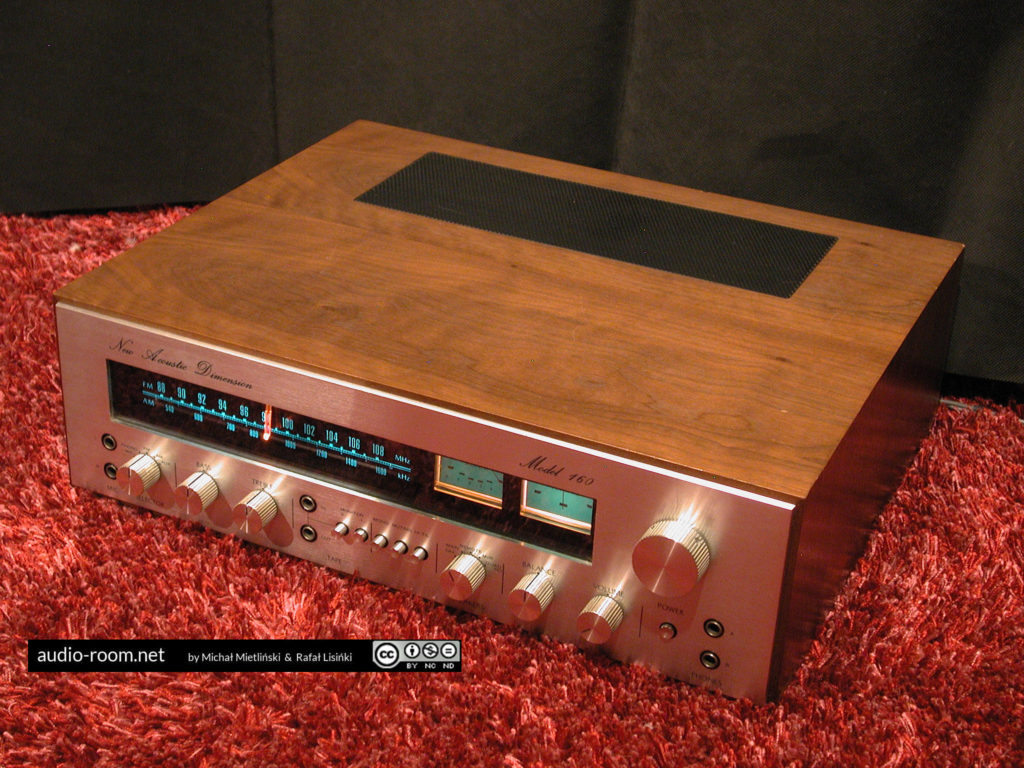NAD’s equipment is mainly associated with design that can be euphemistically called ascetic, and less euphemistically “a Braun, but ugly”. Most people know this brand’s devices made after 1980, and from that time the company consistently sticks to the principle that on the outside a NAD should be gray and boring, and you should buy it for its sound, not appearance. But that was not always the case: the company established in 1972 started with a line of models that can easily compete with the Marantzes and Pioneers in an audio beauty pageant.
I got my NAD Model 160 in a good cosmetic shape, but its technical condition was a disaster. Its previous owner, apparently a solder iron-happy wannabe technician, attempted repairs on his own and almost destroyed this beauty (confused cap values, confused transistor legs). Fortunately, he gave up before the NAD did. And luckily he focused his considerable efforts on the preamplifier section and did not touch the power amp. To my amazement, the receiver would still turn on and even make sound, but certainly not a good one.
After cleaning the mess in the preamp section and replacing resistors in the PS section (a known problem in this model, the values of original resistors are too low and PS overheats), I adjusted bias. I could not find the service manual for this model, but luckily the Model 90 amp from the same line has identical power amp section, so I could use the procedure for Model 90.

At that point I was ready to do the victory dance, but I switched to FM and it turned out that the stereo lamp was dead. so I measured the voltage on the stereo lamp pins and the reading is 42 V (yes, forty two volts). Now that was new, I’ve never seen this voltage on a receiver’s stereo lamp before.
But it turned out that after adding a load (putting a lamp in the circuit), voltage would drop and I could use a standard 12V bulb after all. The receiver was finally ready to play some music.
NAD Model 160 and other models in this line (120, 140, 300 and 160a) are, in my opinion, among the most beautiful receivers from the 1970s. Depending on the source, there are very different years of manufacturing, but most likely this model comes from 1972-73 or 1973-74 – the company was founded in 1972, and in the 1975 catalogue Model 160 is already replaced by its successor, Model 160a that was manufactured until 1978. NAD designers were obviously “inspired” by Marantz – we have the same colour combination of the front panel, dial background and lighting, the word “Model” in the model name, even the font is very similar. Interestingly, Model 160 bears the full brand name “New Acoustic Dimension”, not the abbreviation NAD, like later models.
In my version, the print was dark green, which nicely complemented the green dial light. Fortunately, the layout and shape of knobs have not been copied from Marantz, so is did not look like a knock-off. Another difference was the top cover made of plywood covered with beautiful, natural veneer. With a Marantz you’d have to pay extra for this luxury.
When it comes to functionality, NAD Model 160 has almost everything you need in a vintage receiver. Its amplifier boasts 45 WPC continuous power, above-average for the first half of the 1970s (the standard was 20-30 WPC). This value could be underrated: Model 160A is a 55 WPC receiver according to the manufacturer, and the power amp sections are almost identical in these two versions. In terms of connectivity, there is one phono input and 3 line inputs, including 2 tape loops, one of them duplicated on the front panel. In this version, two line inputs are DIN type, one line input and phono input are standard RCA sockets. There are also microphone inputs on the front panel (separate for the right and left channel) and as many as 2 headphone sockets. Speaker connectors are sprin-type, for bare wires; you can connect 1 or 2 pairs of speakers that can also work in a quasi-quad mode. The remaining functions include a MONO switch, MUTING (removes noise between FM stations) and high filter, while low and loudness filters are missing. This is quite surprising considering that that all other models in this line (lower and higher alike), as well as the successor Model 160A, have loudness filter. There are also no PRE OUT/MAIN IN jacks, which were a standard, for example, in mid and higher Marantz receivers from that period.
And how does it sound? Firstly, not like a NAD at all – there are no “in yer face” forward mids, typical for virtually all well known later models, starting from the iconic 3020 amp. Secondly, it sounds great. A slightly sonic character than in later known and loved NADs does not change the fact that the sound is very pleasant, bass grunt solid, mids are full and smooth, highs are clear without being harsh. Soundstage is reasonably wide and deep. The receiver handles all music genres very well, be it Keith Jarrett’s solo piano, pop, classic rock, or a punk kick from Dead Kennedys. It has no problem powering large floorstanding speakers and high impedance headphones. The FM tuner and phono stage have equally good quality.
The first line of NAD receivers is certainly very interesting. Apart from the brand and overall good sound, they have virtually nothing in common with NAD’s later products. In terms of both sound and looks they are much closer to Japanese and American competitors. We highly recommend Model 160 as a slightly cheaper, and sonically and aesthetically very good alternative to Marantz receivers from the same period. We did not have the opportunity to test the other receivers from in his line, but if Model 160 is representative for the group, we can also expect them to offer great sound and of course very attractive appearance.
Technical information:
Manufacturer: New Acoustic Dimension (NAD)
Model: Model 160
Years: 1972-73 or 1973-74 (probably)
Country: Japan
Continuous power: 2 x 45 in RMS at 8 ohms
Bandwidth (IHF): 15 Hz- 50 kHz
Frequency response: 20 Hz – 20 kHz +/- 0.5 dB
Total harmonic distortion THD (at nominal power): <0.1% (0.3%)
Intermodulation distortion IM (at nominal power): <0.15% (0.4%)
Damping factor at 8 ohms:> 45
Signal/noise ratio for Phono/Mic inputs:> 60 dB
Signal/noise ratio for Tuner/Tape/Aux:> 80 dB
Phono/Mic input sensitivity: 2.2 mV/47 kohms
Tape/Aux input sensitivity: 140 mV/100 kohms
Treble control: +/-10 dB at 15 kHz
Bass control: +/-10 dB at 100 Hz
Dimensions: 45 x 14 x 36 cm
Weight: approx. 16 kg
Gallery:






At last, a little love for this venerable receiver! I managed to find one with a few missing knobs that I had refurbed by someone capable. It sounds terrific and, as you rightly say, they look great too. Mine pulls in a very strong signal with just a basic indoor aerial and I use a step up transformer into the phono stage to run a Denon MC in a very standard Lenco 75. Lovely.
Ha Timo, ik heb er ook een waar 4 afwijkende knoppen op zitten. Hoe heb jij de juiste knoppen kunnen vinden? Zou de 160a graag weer compleet hebben als hart van m’n vintage set!
I think your best bet is to find and buy a faulty NAD 160s/160/140/120/60 (these models use the same knobs, other models from the same line have different knobs), get the knobs that you need and then resell the rest to get some money back. It will take some time to find it though. In the meantime, you can buy a set of 6 new aluminum knobs – they will be different from the original, but at least they will match each other.
Hi,
I own a NAD 160a. The needle of the tuner is broken and (horribly) fixed by the previous owner. I would like to know how the needle fixation to the string meganism looks like originally and which bulb is used for lighting the needle. Is there any chance you have some pictures of that parts?
Thanks in advance,
Have a look at the penultimate picture in the gallery ( http://audio-room.net/wp-content/gallery/nad-model-160/NAD-160-DDSCN9935.JPG ). This is the best I have. The bulb is inside the pointer (needle) fitting, right above the pointer, supplied by the two black wires.
“…and you should buy it for its shoud..”
Surely you meant to say…sound? Ok
I absolutely did. Corrected, thank you!
Nad 160 main power transformer
Hi.
My main power transformer has come to its end. I cant seem to find a lot of data about it on the net so I am wondering if, perhaps you have an idea how to find one.
Kind regards.
Tom
Hi Tom,
Your best bet would be to find a damaged NAD 160 with a working transformer and buy it for parts. Alternatively, you can try to find a company that makes transformers to spec and order one. They should be able to figure out the voltages you need based on the schematic diagram (available for both NAD 160 and 160a) or the original transformer. Or look for a workshop that repairs transformers. The availability of such services will depend on your location so if you don’t find anything locally, search all over your country – it might turn out to be cheaper to send your transformer for repairs to another city than to order a new one or buy a damaged receiver for parts.
Good luck,
Rafal
Hi.
THX a lot for all the info. I am looking all over the net and hoping to find it. Now I will start to look if there is a repair workshop in the area. I hope to fix the NAD because it realy is a beautifull sounding peace of vintage equipment.
Regards,
Tom